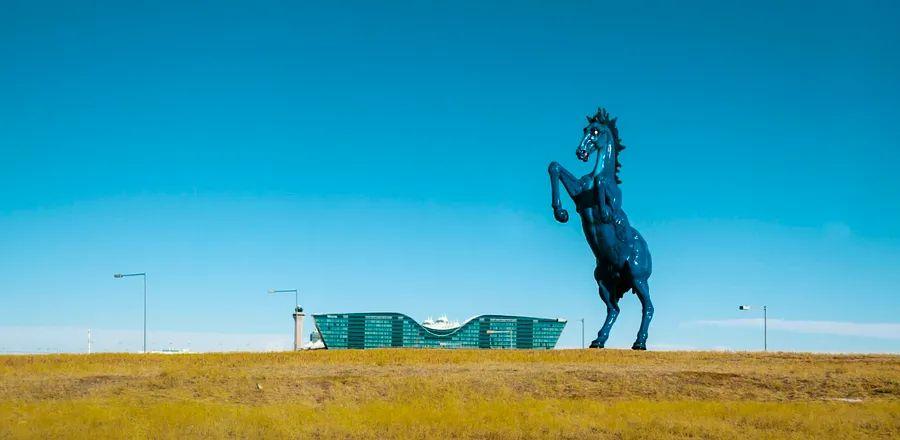Discover the 10 Largest Airports in the U.S.—A List That May Surprise You

A large airport can often resemble a bustling city—or an "aerotropolis,” a term that captures the essence of these emerging mega-airport-commerce hubs. Indeed, the largest U.S. airfields are as expansive as a good-sized city. Like any major urban center, they are in a continuous cycle of development, with new terminals springing up to cater to the ever-increasing number of travelers. Last year, U.S. airports processed over 1 billion passengers flying both domestic and international routes, according to the U.S. Bureau of Transportation Statistics, and this number is projected to keep growing in the years ahead.
So, which U.S. airports claim the title of the largest by land area? Interestingly, they are not always the busiest; for instance, Atlanta’s Hartsfield-Jackson International Airport, the world leader in passenger traffic, doesn't even make the top 10 when it comes to size. Here’s the ranking based on the airports’ published dimensions and data from local authorities.
1. Denver International Airport (DEN): 53 square miles
Denver International Airport ranks as the second largest airport in the world, trailing only the massive King Fahd Airport in Saudi Arabia—it’s so expansive that it surpasses the next largest U.S. airport, Dallas Fort Worth, by more than double. Spanning 53 square miles, it’s larger than the cities of San Francisco, Boston, and Miami combined. This was no accident; in the 1990s, Denver decided to replace its outdated Stapleton airport with a new site located 25 miles from downtown. This strategic choice allowed for the construction of six runways, and the airport recently completed a terminal expansion that added 39 new gates, raising the total across its three terminals to 90 (a 30% increase). The airport occupies only a small portion of its vast landholdings, which offer numerous outdoor experiences, including an 82,000-square-foot plaza open to travelers and the public. Additionally, its terminals feature three outdoor decks beyond security, showcasing views of the distant Colorado plains.

Shutterstock
2. Dallas Fort Worth International Airport (DFW): 26 square miles
The saying “everything is bigger in Texas” applies not only to large hats and hair but also to its colossal airports: The Lone Star State boasts two of the largest airports in the U.S. As the hub for American Airlines, the world’s largest airline, Dallas Fort Worth International Airport covers an area larger than Manhattan; it even has its own zip code and features five terminals with a total of 168 gates. Despite its size, the airport is a leader in sustainability, with plans for a zero-carbon power plant aimed at achieving net-zero emissions by 2030. With seven active runways, it accommodates over 73 million passengers annually, who enjoy a variety of dining options and facilities like an internal walking path and a yoga studio to stay active.

Christoffer Hansen Vika/Shutterstock
3. Southwest Florida International Airport (RSW): 21.2 square miles
Although it may not rank high in passenger volume—serving just over 10 million travelers last year—Southwest Florida International Airport in Fort Myers is the third largest airport in the U.S. by area. Strategically located as the gateway to Florida’s southwest region, it caters to destinations including Cape Coral–Fort Myers, Naples, Marco Island, and Punta Gorda. The airport's expansive footprint isn't intended for future expansion; instead, it focuses on land conservation, with approximately 6,000 acres designated as protected wetlands. Meanwhile, an ongoing terminal expansion is set to be completed by early 2025.

Courtesy of Brightline
4. Orlando International Airport (MCO): 20.7 square miles
Situated just six miles from downtown Orlando, this airport serves as the primary international gateway for central Florida and its renowned theme parks. As the seventh busiest airport in the nation, Orlando International Airport now operates 850 daily flights across 44 airlines, welcoming throngs of visitors from both the U.S. and abroad to this beloved family destination. Last year, MCO set a record by accommodating nearly 58 million passengers, marking a 15 percent rise from the previous year. The airport has recently unveiled the new $2.8 billion Terminal C and Florida’s latest private high-speed rail service, with Brightline opening a station at the airport.

Photo by Cyrus Crossan/Unsplash
5. Washington Dulles International Airport (IAD): 18.7 square miles
When Dulles Airport opened in the rural expanse of Northern Virginia in the early 1960s, its vast land was considered a liability; situated 30 miles from the capital, insiders viewed it as a bit of a white elephant, despite the airport’s stunning terminal designed by Eero Saarinen. Today, it has transformed into a thriving aerotropolis, surrounded by numerous technology firms and defense contractors. A significant hub for United Airlines, the airport offers flights to 57 international and 86 domestic destinations. Although the drive from the district can still take nearly an hour, a Metro line expansion now provides a public transit option.

Julie Soefer/George Bush Intercontinental Airport
6. George Bush Intercontinental Airport (IAH): 17.1 square miles
In the late 1950s, when Houston civic leaders acquired land for a new airport, they were already envisioning significant growth—and over the decades, the airport's footprint has expanded to its current size. George Bush Intercontinental Airport Houston now boasts five runways that accommodate a large volume of long-haul flights to Latin America and beyond, with Houston as a central hub for United Airlines. By early 2025, the airport plans to unveil a new international terminal located between terminals D and E, a necessary addition after handling a record 46 million travelers last year.

James Udall/Salt Lake City International Airport
7. Salt Lake City International Airport (SLC): 12 square miles
Salt Lake City International Airport, a key hub for Delta Air Lines, proudly claims the title of the “first U.S. hub airport constructed in the 21st century,” featuring a new complex that debuted in 2020, replacing a 60-year-old facility that was in dire need of modernization. The initial phase of the $4 billion redevelopment received rave reviews from travelers for its contemporary design, spacious layout, and art that reflects the state's distinctive landscape. With a surge in international traffic, the airport now offers nonstop flights to destinations like Amsterdam, London, and Paris, serving over 26 million passengers annually, with capacity expected to rise to 34 million upon the completion of the final phase in 2026.

Patrick L. Pyszka/City of Chicago
8. Chicago O’Hare International Airport (ORD): 11.25 square miles
Chicago's primary airport is bustling, frequently challenging Atlanta for the highest passenger numbers, with nearly 74 million travelers passing through in 2023, primarily flying with American and United Airlines, the latter headquartered in Chicago. The airport is also substantial in scale, featuring 202 gates and eight runways, thought to be the most of any commercial airport globally. Recently, O’Hare initiated a comprehensive $8.5 billion terminal modernization initiative, set to wrap up by 2028.

Ivan Mendoza/Unsplash
9. San Francisco International Airport (SFO): 8.14 square miles
In 2023, San Francisco International Airport welcomed 50 million passengers, serving as a key hub for travel to the Asia Pacific. It features the largest international terminal in the U.S., covering 1.8 million square feet, complete with a customs facility that processes up to 5,000 arrivals per hour. Travelers can also enjoy various outdoor areas, such as the new Sky Terrace at Terminal 2, offering a 180-degree view of the airfield, and an exhibit gallery showcasing the airport’s history. Built to withstand earthquakes, it can endure up to a magnitude 8 quake, significantly higher than the last major quake of 6.9 on the Richter scale.

Courtesy of the Port Authority of New York and New Jersey
10. John F. Kennedy International Airport (JFK): 8.1 square miles
New York City’s JFK airport has transformed significantly since its opening in 1948 as Idlewild Airport on a former golf course. Renamed in honor of President Kennedy in 1963, it became the international gateway to the U.S. Initially, the airport utilized its spacious grounds to feature outdoor plazas with fountains and landscaped areas, which were later replaced by additional roadways and terminals. Currently, JFK is undergoing a substantial renovation aimed at creating a more efficient and environmentally friendly facility. This upgrade will significantly enhance the airport's indoor space, accommodating 62 million passengers annually across 90 airlines, solidifying its status as the busiest airport in the U.S. for international flights.
Evaluation :
5/5



